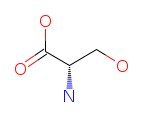Serine
Despite the fact that Serine is one of the most difficult of all the amino acids to obtain from proteins, it somehow appeared to be one of the early amino acids that has been discovered. Cramer first obtained Serine from silk in 1865 and this compound was later synthesized by Fischer and Leuchs in the early 20th century from glycolic aldehyde using the Strecker cyanohydrin method.
Chemical Structure of L-Serine

Identifiers and properties of Serine
IUPAC Name: (2S)-2-Amino-3-hydroxypropanoic acid
Symbol: Three-letter code - Ser. One-letter code - S
Molecular Weight (Molar Mass): 105.09258 g/mol
Molecular Formula (Structural Formula): C3H7NO3
Canonical SMILES: C(C(C(=O)O)N)O
Isomeric SMILES: C([C@@H](C(=O)O)N)O
InChIKey Identifier: MTCFGRXMJLQNBG-ODVHTPRODA
CAS Number: 56-45-1
MDL Number: MFCD00064224
Melting point: 222 °C
RNA codons: AGC, AGT, TCA, TCC, TCG, TCT
Solubility in water: 250 g/L (20 °C); pKa - 2,21; pKb - 9,15
Rf value in n-butanol/acetic acid/water = 12:3:5 - 0.27
2D Molfile: Get the molfile
3D PDB file: Get the PDB file
Other names: beta-Hydroxyalanine; (S)-Serine
What is the role of Serine?
Generally speaking, Serine plays an important role in various biosynthetic pathways. In addition, it is the precursor to a number of amino acids like Glycine and Cysteine. Besides, it also helps an enzyme catalyze its reaction - the hydrolysis of peptide bonds in polypeptides and proteins, which is basically a major function in the digestive process.
Serine is recognized as a non-essential amino acid obtained from another amino acid called Glycine and is believed to be important to overall good health, both physical and mental. This amino acid is particularly essential for proper functioning of your brain and of your central nervous system.
One of the Serine's functions is to help form the phospholipids which are necessary for creating every cell in the human body. In addition, this amino acid is involved in the functioning of RNA and DNA, in the muscle formation as well as in the maintenance of a proper immune system. Tryptophan, an essential amino acid used to make serotonin (a mood-determining brain chemical), also cannot be produced without Serine. Meanwhile, both serotonin and Tryptophan shortages are believed to cause depression, insomnia, and anxiety. Numerous researches suggest that low levels of this amino acid are responsible for the chronic fatigue syndrome and fibromyalgia.
Serine is also known for assisting in production of immunoglobulins and antibodies for a healthy immune system, as well as for helping in the absorption of creatine that helps build and maintain the muscles.
Food sources
To create proper conditions for Serine to be produced in the human body, you may need a sufficient amount of vitamin B and folic acid. Naturally, this amino acid can be derived from meat and soy foods, from dairy products, and from peanuts, but taking into account the modern Western diet including too much processed convenience food, it may be harder to obtain it than you realize. Here are some foods that contain serine.
• Poultry. Turkey and chicken are good sources of serine.
• Fish. Many types of fish, such as salmon and tuna, contain serine.
• Dairy Products. Milk, cheese, and yogurt are sources of serine.
• Soy Products. Foods made from soy, such as tofu and soybeans, are rich in serine.
• Nuts and Seeds. Sunflower seeds, pumpkin seeds, and peanuts are examples of nuts and seeds that provide serine.
• Meat. Beef and pork also contain serine.
It's important to note that the exact serine content can vary depending on factors like the specific type of food, preparation methods, and other ingredients in the dish. For more precise information on the serine content of specific foods, you may refer to nutritional databases or food labels. If you have specific dietary concerns or health conditions, it's advisable to consult with a healthcare professional or a registered dietitian for personalized advice.